Stories about the Hindu God Ganesha
- How Ganesha Got His Elephant Head
- How Ganesha Broke His Tusk
- Ganesha battles Parashu-Rama
- Ganesha the Scribe
- Ganesha Curses the Moon
- Why Ganesha Rides a Mouse
- How Ganesha became Ganapati
- Ganesha and Lord Kubera
- Ganesha and The Demon Ravana
- Ganesh and The Goddess Parvati
- Links to Other Ganesh Stories

How Ganesha Got His Elephant Head
There are several stories about the birth of Ganesha and the origin of his elephant head. The most well know is this story found in the Shiva Purana.

"Once, while his mother Parvati wanted to take a bath, there were no attendants around to guard her and stop anyone from accidentally entering the house. Hence she created an image of a boy out of turmeric paste which she prepared to cleanse her body and infused life into it, and thus Ganesha was born. Parvati ordered Ganesha not to allow anyone to enter the house, and Ganesha obediently followed his mother's orders. After a while Shiva returned from outside, and as he tried to enter the house, Ganesha stopped him. Shiva was infuriated at this strange little boy who dared to challenge him. He told Ganesha that he was Parvati's husband, and demanded that Ganesha let him go in. But Ganesha would not hear any person's word other than his dear mother's. Shiva lost his patience and had a fierce battle with Ganesha. At last he severed Ganesha's head with his trishula. When Parvati came out and saw her son's lifeless body, she was very angry and sad. She demanded that Shiva restore Ganesha's life at once.
Unfortunately, Shiva's trishula was so powerful that it had hurled Ganesha's head very far off. All attempts to find the head were in vain. As a last resort, Shiva approached Brahma who suggested that he replace Ganesha's head with the first living being that came his way which lay with its head facing north. Shiva then sent his celestial armies (Ganas) to find and take the head of whatever creature they happened to find asleep with its head facing north. They found a dying elephant which slept in this manner, and after its death took its head, attaching the elephant's head to Ganesha's body and bringing him back to life."
Source: http://en.wikipedia.org/wiki/Mythological_anecdotes_of_Ganesha
Return to Top
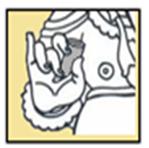
How Ganesha Broke His Tusk
In many images of Ganesha, he is shown holding his own broken tusk. (sometimes both tusks are broken). There are several stories that tell how Ganesha broke his tusk and acquired the name Ekadanta "one toothed". As always, there are many versions of each of these legends.
In the first explanation, Lord Ganesha looses his tooth during a battle. Sometimes the battle is against a mighty demon who threatens both humans and gods. In other stories, Ganesha must battle Parashu-rama (Rama with an axe) an incarnation of Lord Shiva. Another explanation for Ganesha broken tusk, is that he broke off his own tusk to use as a quill as he transcribed the holy Vedas for the sage Vyasa. From this story, Ganesha acquires the name Vidya Ganapati (God of Education). The image of Ganesha’s broken tusk becomes symbolic of the sacrifice Ganesha made to give the Vedas to the people. In return, every student and scholar must sacrifice part of himself in the pursuit of knowledge. The third account of how Ganesha lost his tusk, says that Ganesha threw his tusk at the moon, when the moon laughed at his folly. He also put a curse on the moon resulting in the pattern of waning and waxing we see today.
A) Ganesha battles Parashu-Rama
"One day, Parashu-Rama, an avatar of Vishnu, went to pay a visit to Shiva, but along the way he was blocked by Ganesha. Parashu-Rama hurled himself at Ganesha with his axe and Ganesha (knowing that this axe was given to him by Shiva) allowed himself out of respect to be struck and lost his tusk as a result."
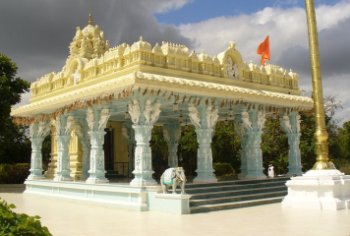
B) Ganesha the Scribe
"In the first part of the epic poem Mahabharata, it is written that the sage Vyasa asked Ganesha to transcribe the poem as he dictated it to him. Ganesha agreed, but only on the condition that Vyasa recite the poem uninterrupted, without pausing. The sage, in his turn, posed the condition that Ganesha would not only have to write, but would have to understand everything that he heard before writing it down. In this way, Vyasa might recuperate a bit from his continuous talking by simply reciting a difficult verse which Ganesha could not understand. The dictation began, but in the rush of writing Ganesha's feather pen broke. He broke off a tusk and used it as a pen so that the transcription could proceed without interruption, permitting him to keep his word."
(The photo at right is a temple to Ganesha at BVRIT, an engineering college in India.)
C) Ganesha Curses the Moon
"It is said that one day Ganesha, after having received from many of his devotees an enormous amount of sweets (Modaka), in order to better digest this incredible mass of food, decided to go for a ride. He got on the mouse which he used as his vehicle and took off. It was a magnificent night and the moon was resplendent. Suddenly a snake appeared out of nowhere and nearly frightened the mouse to death, causing it to jump and Ganesha was thrown off his mount. Ganesha's huge stomach smashed against the ground so forcefully that it burst open and all of the sweets that he had eaten were scattered around him. Nonetheless, he was too intelligent to get angry about this accident and, without wasting any time in useless lamentations, he tried to remedy the situation as best he could. He took the serpent which had caused the accident and used it as a belt to keep his stomach closed and bandage the injury. Satisfied by this solution, he remounted his mouse and continued his excursion.
Chandradev (Moon God) saw the whole scene and laughed. Ganesha, being the short-tempered one, cursed Chandradev for his arrogance. Then breaking off one of his tusks, hurled it against the Moon, slashing its luminous face in two. He then cursed it, decreeing that anyone who happens to see the moon will incur bad luck. Hearing this, Chandradev realized his folly and asked for forgiveness from Ganesha. Ganesha relented and since a curse cannot be revoked, only softened it. Ganesha softened his curse such that the moon would wax and wane in intensity every fifteen days and anyone who looks at the moon during Ganesh Chaturthi would incur bad-luck."
Source: http://en.wikipedia.org/wiki/Mythological_anecdotes_of_Ganesha
Return to Top
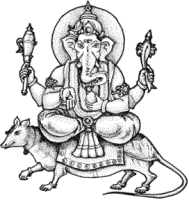
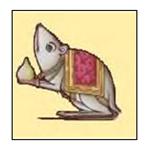
Why Ganesha Rides a Mouse
Ganesha's vehicle (Mushika) was originally Gandharva Krauncha, a celestial musician, who absentmindedly walked over the feet of a rishi (wise man) named Vamadeva. The Rishi cursed Krauncha, transforming him into a large rat. The man-sized rat, began to cause a lot of trouble. The Rishi invoked Vinayaka (Ganesha) for help. Ganesha trapped the rat with his lasso, subduing him. By this time, the Rishi had recovered his temper. He did not undue his curse, but instead allowed Mushika the honor of remaining the loyal mount of Lord Ganesha.
Ganesha's mouse, represents a person's ego, and harmful qualities like greed, fear and
pride. Ganesha reminds us that we must reign in our egos and control our baser emotions.
Source: http://www.csuchico.edu/~cheinz/syllabi/asst001/spring99/Karmegam/icon.html
Return to Top
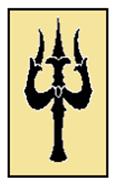
How Ganesha became Ganapati
(The Leader of the Ganas)
"There once took place a great competition between the Devas to decide who among them should be the head of the Gana (the troops of semi-gods at the service of Shiva). The competitors were required to circle the world as fast as possible and return to the Feet of Shiva. The gods took off, each on his or her own vehicle, and even Ganesha participated with enthusiasm in the race; but he was extremely heavy and was riding on a mouse! Naturally, his pace was remarkably slow and this was a great disadvantage. He had not yet made much headway when there appeared before him the sage Narada (son of Brahma), who asked him where he was going. Ganesha was very annoyed and went into a rage because it was considered unlucky to encounter a solitary Brahmin just at the beginning of a voyage. Not withstanding the fact that Narada was the greatest of Brahmins, son of Brahma himself, this was still a bad omen. Moreover, it wasn't considered a good sign to be asked where one was heading when one was already on the way to some destination; therefore, Ganesha felt doubly unfortunate. Nonetheless, the great Brahmin succeeded in calming his fury. Ganesha explained to him the motives for his sadness and his terrible desire to win. Narada consoled and exhorted him not to despair; he said that the whole world was embodied within Shiva, so all Ganesha had to do was to circle his father and he would defeat those who had more speed but less understanding.
Ganesha returned and circled his father, who asked him how he was able to finish the race so quickly. Ganesha told him of his encounter with Narada and of the Brahmin's counsel. Shiva, satisfied with this response, pronounced his son the winner and, from that moment on, he was acclaimed with the name of Ganapati (conductor of the celestial armies) and Vinayaka (lord of all beings)."
Source: http://en.wikipedia.org/wiki/Mythological_anecdotes_of_Ganesha
Return to Top

Ganesha and Lord Kubera
This story found in the Purana, narrates the story of Ganesha and lord Kubera, the treasurer of Svarga (paradise) and god of wealth.
" Kubera, went one day to Mount Kailash in order to receive the darshan (vision) of Shiva. Since he was extremely vain, he invited Shiva to a feast in his fabulous city, Alakapuri, so that he could show off to him all of his wealth. Shiva smiled and said to him: "I cannot come, but you can invite my son Ganesha. But I warn you that he is a voracious eater." Unperturbed, Kubera felt confident that he could satisfy even the most insatiable appetite, like that of Ganesha, with his opulence. He took the little son of Shiva with him into his great city. There, he offered him a ceremonial bath and dressed him in sumptuous clothing. After these initial rites, the great banquet began. While the servants of Kubera were working themselves to the bone in order to bring the portions, the little Ganesha just continued to eat and eat and eat. His appetite did not decrease even after he had devoured the servings which were destined for the other guests. There was not even time to substitute one plate with another because Ganesha had already devoured everything, and with gestures of impatience, continued waiting for more food. Having devoured everything which had been prepared, Ganesha began eating the decorations, the tableware, the furniture, the chandelier. Terrified, Kubera prostrated himself in front of the little omnivorous one and supplicated him to spare him, at least, the rest of the palace.
"I am hungry. If you don't give me something else to eat, I will eat you as well!", he said to Kubera. Desperate, Kubera rushed to mount Kailasa to ask Shiva to remedy the situation. The Lord then gave him a handful of roasted rice, saying that something as simple as a handful of roasted rice would satiate Ganesha, if it were offered with humility and love. Ganesha had swallowed up almost the entire city when Kubera finally arrived and humbly gave him the rice. With that, Ganesha was finally satisfied and calmed."
Source: http://en.wikipedia.org/wiki/Mythological_anecdotes_of_Ganesha
Return to Top

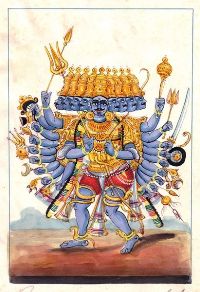
Ganesha and The Demon Ravana
It is said, that a man or demon may win favors from the Gods by performing difficult tapas (religious austerity). The demon Ravana worshiped Shiva devoutly and performed many strict tapas. As a consequence, the god agreed to grant Ravana a boon. Ravana's request was that his kingdom would become a mighty empire, which could never be conquered or destroyed.
To make this so, Shiva gave him his own Shiva Lingam, (the symbol of Shiva) he told Ravana to take it back to his kingdom and place it in a temple. As long as the Shiva Lingam remained in his capital, his kingdom would be unconquerable.
But there was a prerequisite: Once he gave Ravana the lingam, it must never touch the ground, even for a moment, until it was installed in its temple. Once the Lingam was set down, no one would be able to move it from that spot.
When the other Deva (Gods) heard of Shiva’s gift to Ravana, they began to worry that the evil Demon was becoming too strong. Ravana power could disrupt the balance of the world’s Dharma. The Devas asked Ganesha to think of a way to stop the demon king, for Ganesha was known for is wisdom and cunning.
(*see an alternate version below)
Ganesha called Varuna, the god of Waters, and asked him to make the water Ravana drank impure, which would make Ravana ill. Soon after, Ravana abdomen began to churn and spasm with pain. Yet, he could not lay the Lingam down to attend to his business. In desperation, Ravana looked around, but the only person he saw was a small boy playing in the ocean surf. Ravana yelled at the boy to come to him. He thrust the lingam into the boy’s arms. Fiercely he told the boy to stay where he stood; hold the stone in his arms and not let it touch the ground. Then Ravana ran behind a clump of bushes.
Unknown to Ravana, the little boy was actually Ganesha in disguise. In the boy’s voice, Ganesha called out, "My lord, this big stone is too heavy; I can not hold it for long." From the bushes Ravana yelled, "Do not set down the stone, boy or I will chop off your head and devour you intestines like noodles" Again Ganesha called out, "My lord, this stone is so heavy. I am scared by your words, so my legs shake. I can not hold it any long."
Ganesha laid down the stone.
There was nothing Ravana could do. The stone Lingam could never be moved again, so he was unable to take it its temple in his capital city. Without Shiva Lingam, his kingdom was only as strong as any other mortal kingdom.
(The place where the Lingam was laid is called Gokarna, and is located in Karnataka, on the western coast of India. Hindus still go there to worship Lord Shiva.)
* Version 2:
"....Ravana was on his way to Lanka carrying Shiva's Atmalinga in his palms. He came to the west coast. By then it was evening. It was time for Ravana to perform the sandhya-vandana (the evening prayers). Ravana was in a fix. Ishwara (Shiva) himself had told him that the Lingam should not touch the ground. How was he to perform sandhya- vandana, with the Atmalinga in his hands? There was no one in that deserted place that could help him. He stood there, thinking, "I must perform sandhya-vandana. What shall I do?" ......
[Ravana see a young boy, and tells him to hold the Lingam.] ...... Hardly had Ravana started when Ganesha (disguised as a small boy) cried out, "Alas, it's too heavy! Too heavy!" Ravana was afraid. But, he could not return without completing sandhya-vandana. Therefore, he cried out, "Boy, I shall be back soon. Don't put the Lingam on the ground whatever may happen." By the time Ravana was offering holy water to the gods Ganesha cried aloud, "Oh, Ravana, I can no longer bear the weight of this Lingam; I shall put it down here." So saying, Ganesha put the Lingam on the ground and ran away. Ravana completed sandhya- vandana in haste and ran back in fear. But Shiva's Atmalinga was firm in the earth. No matter how hard he tried, Ravana could not take it out....."
(Source: http://www.freeindia.org/biographies/gods/ganesha/page14.htm)
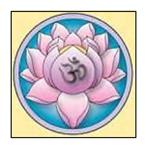
Ganesh and The Goddess Parvati (Ganesha learns a lesson)
One day, the child Ganesha was playing roughly with a cat. He pulled its tail and rolling him on the ground. When he grew board with this diversion, he left the cat and went in search of his mother, The Goddess Parvati. When he found her, he was surprised to find her in a terrible state. Her cloths were torn and covered with dust and there were sore bruises on her arms and body.
"Mother what has happened? Who has done this to you?" Her child asked.
"Indeed, it was You Ganesha who has done this. As I am Shakti Uma. I am part of the eternal Brahma, and so was the cat who you mistreated."
On this day, Ganesha learned an important lesson. All living beings are part of the Divine. If we injure a living creature - another human, an animal, or even ourselves - we injure God.
Visit these sites to read more of Ganesha's Stories:
- Mythological Anecdotes of Ganesha - en.wikipedia.org
- Ganesha Stories - www.shreedarshan.com
- Grandpa Stories - www.hindukids.org
- Kids Stories - www.balagokulam.org
- Ganapati Myths - www.ganapati.perso.neuf.fr
- Ganesha Stories - www.dhrishticreations.com
- Biography of Ganesha - www.freeindia.org


